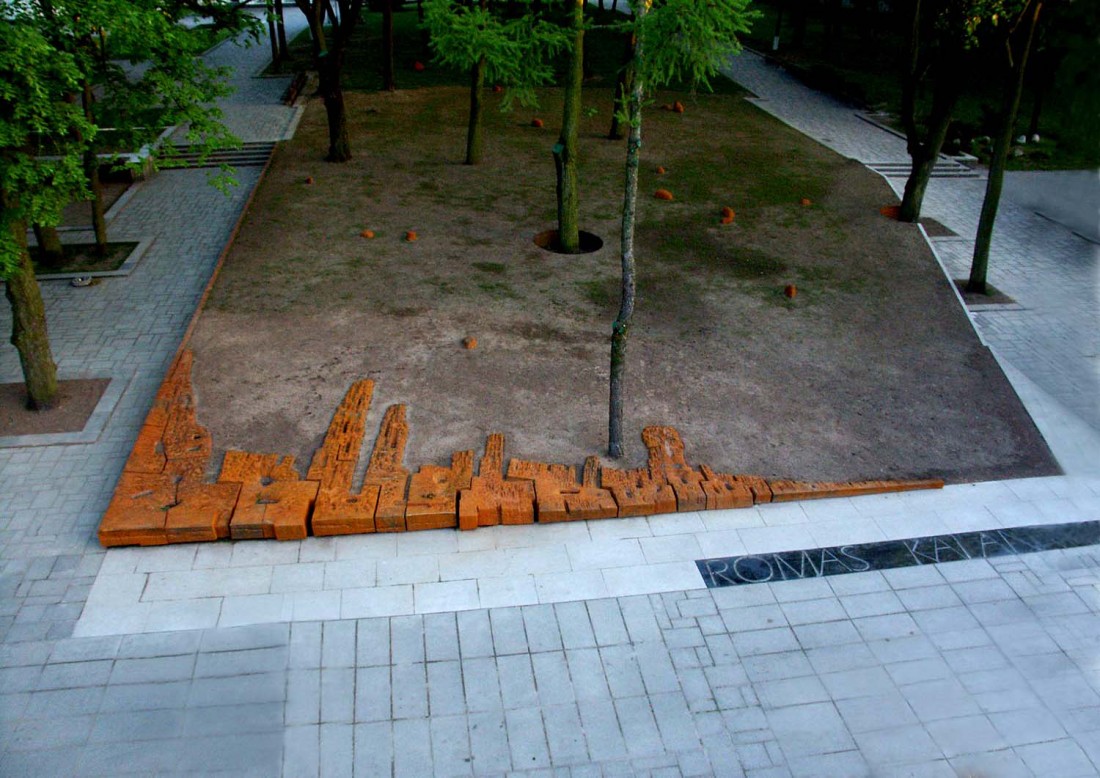Robertas Antinis
Robertas Antinis is constantly experimenting not because he had not found his own stylistics or method, but because of his creative temperament. According to the artist: “An author has to be young, elemental. That element, otherness, outlook, comprehension, naivete, inability to express, a desire to say or, on the contrary, not to say, and the saying being different than not saying, or the not saying being different from saying”.
Therefore, those who are familiar with the principles of Robertas Antinis’ creative work were not surprised to see his piece “Field of Sacrifice” was unveiled at the place of death of Romas Kalanta, the park of Musical Theatre, in 2002. However, most of community was left baffled and confused. After all, the sculptor was contradicting the established form of sculpture, traditional method of immortalising (the usual realistic vertical figure that can be walked around, looked over, taken photos with). The modern work of art “Field of Sacrifice”, opposite of all that, cannot even be noticed immediately. The monument merged into this important historical place barely altering it. This piece is close to ground art. The dedicated plot of land in the park where the tragic event happened. It contains 19 burnt cast iron stones, one for each year that Romas Kalanta was alive. The front boundary is marked by a cracked metal edge, as a page from an unreadable book.
Indeed, the audience and the perceiver are very important to Robertas Antinis. He maintains that people can walk through this piece, take a seat with their friends, simply spend time in it without knowing much about it. That is where the power of the piece comes from. It is not without reason that the artist has said: “Sometimes a person doesn’t even have to know that they are on, through or close to a work of art. No need to know who made it. No need for tangibility”. This way other matters become significant – the merging of art and the environment, dissolution of boundaries. When a person does not “find” the monument in a traditional sense, they start thinking about the entirety of it all, the horrifying event, about what is gone and what remains.
Exciting and unusual “Field of Sacrifice” should ostensibly remind of Robertas Antinis’ life as well. This place has not left him ever since 14 May, 1972. He, just like many others, who passed by the place during those days (referred to as “Kalantinės” or Days of Kalanta) was noticed by the secret police, interrogated by them and watched right up until the independence. During the first years of independence the sculptor started sketching the memorial, so it was not a spontaneous idea. The sculptor immediately realised the memorial has to be horizontal, since there was already an abundance of vertical ones around the city. Plastic expression was chosen just as responsibly: “A cast form appeared that one could associate with fire and heat. I thought the most appropriate material to be cast iron. It reflects the processes better than other metals. Cast iron is ever-changing, it is rougher, not as elegant. Bronze just would not do here. History has to be considered in the making of a memorial, it dictates certain forms”
This is not the only memorial created by Robertas Antinis in Kaunas, but an extended look at this subtle and modern capture of the past might just impel onlookers to seek out more sculptures by the artist in public spaces.
Robertas Antinis was born in 1946, in Kaunas. In 1965 he graduated from Riga Applied Arts School, and in 1970 finished the studies of industrial art at the Art Academy of Latvia. After his return to Kaunas, he created numerous small-scale works and sculptures in public spaces. Member of the Post Ars group since 1989. In 2002 he was awarded with the Lithuanian National Culture and Art Prize, and in the same year – with the Order of the Lithuanian Grand Duke Gediminas, Officer’s Cross.
Back to the map
